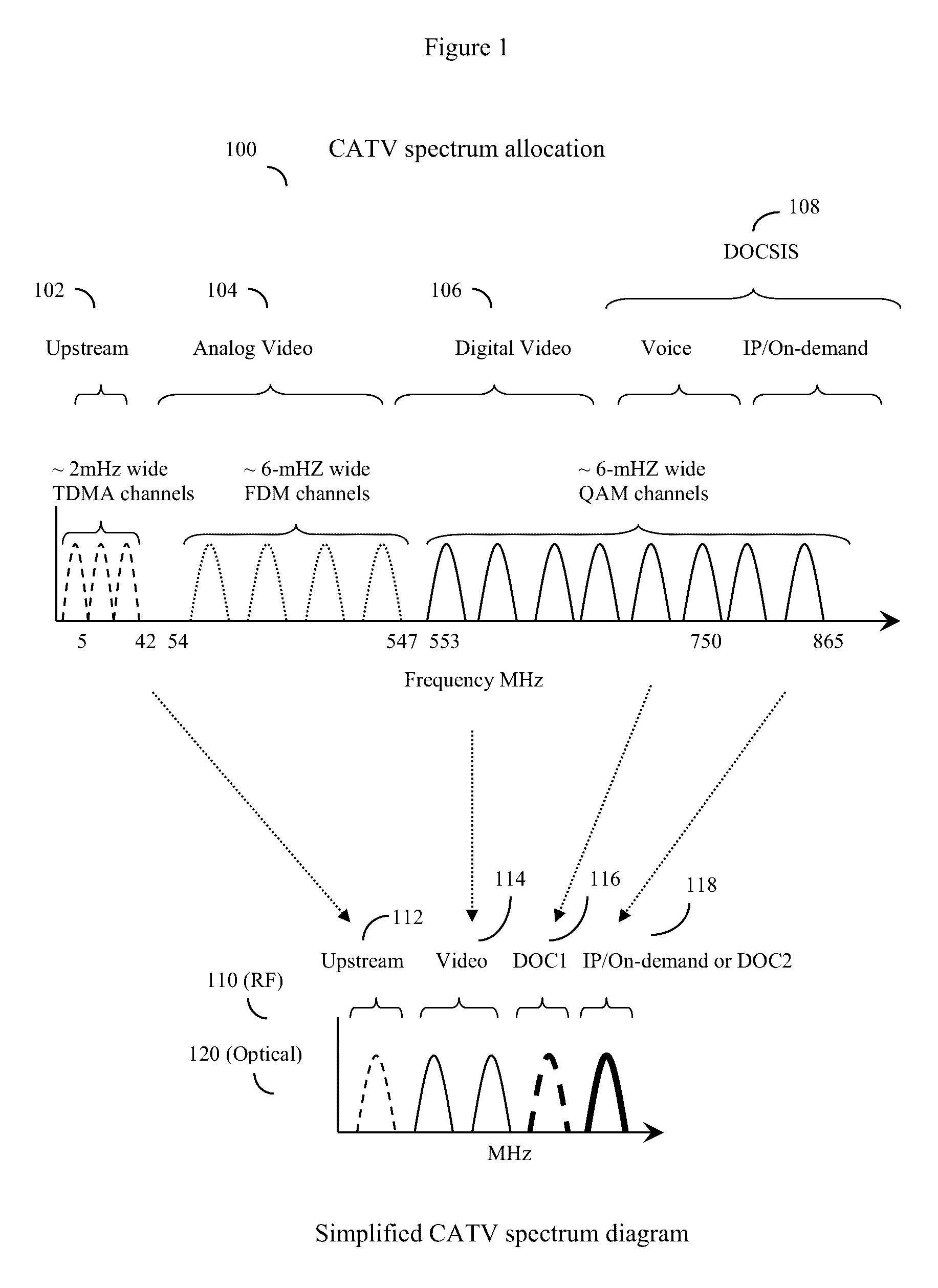[0051]One advantage of the invention's CMRTS units is that because they can be designed to be highly software configurable, and additionally to have software configurable hardware as well due to FPGA and DSP based MAC and PHY components, the same CMRTS units can be reconfigured to work with the first backwards compatible CMRT option, the second more radical CMTS option (design), or a wide variety of other options, such as the previously discussed virtual CCAP system as well. Because the CMRTS design is both software configurable and in some configurations can (but need not) allow for the pass through of prior art CATV RF to optical signals, the CMRTS can be configured to be also highly backward compatible as needed, and can be implemented in a way that can be largely transparent to the cable operator until the higher functionality of the CMRTS is required.
[0052]In some embodiments, the first communications media, used to transmit legacy CATV data over the optical fiber, may handle a substantial part of the data that is ultimately delivered to and from the various sections of neighborhood cable. In other embodiments, the first communications media may handle no legacy CATV data whatsoever, and all data that is ultimately delivered to and from the various sections of neighborhood cable will travel through the second communications media. In these later embodiments, there essentially may be no first communications media. Nonetheless, because the present invention enables both possibilities, it is useful to retain the nomenclature of a first communications media that is used to transmit legacy CATV signals over optical fiber, and a second communications media, which may physically be identical with the first communications media, that is used to transmit Ethernet data packets / frames and the like that will require either decoding and reformatting at the CMRTS units, or else remodulation at the CMRTS units, in order to transfer information between the optical and cable portions of the HFC system.
[0053]For either the first or second option, the second communications media used to transmit data to the CMRTS may optionally use a second optical fiber and an alternative data transmission protocol, such as various Ethernet protocols previously discussed. If this scheme was used, the data would require conversion, reformatting, and QAM modulation by the remote CMRTS units. Here, for example, the FPGA and DSP units in the CMRTS units could be configured as QAM modulators that would then provide a radiofrequency (RF) QAM signal that can be injected into the cable, and recognized by cable modems attached to the various cables. In this configuration, to avoid conflicts, if any data is being transmitted over the first communications media, then to avoid interference, it may be useful to have the frequency (or at least time slice) of the QAM waveforms provided by the CMRTS units differ from the frequency (or at least time slice) of any QAM waveforms provided by the central CMTS QAM modulators.
[0054]Alternatively, this second communications media may carry data to the CMRTS units using the same (first or main) optical fiber that may have been or could have also been used to carry QAM signals from the CMTS. In this alternative configuration, the CMRTS data may be carried at an alternate wavelength if desired. For example, the CMTS data, which may carry any main package of CATV TV stations and perhaps some DOCSIS services, may, if it exists, communicate using a 1310 nm optical wavelength, while the CMRTS data, which may carry the supplemental IP / On-demand data, may communicate using a 1550 nm optical wavelength. This type of scheme is often called wavelength-division multiplexing. As previously discussed, this supplemental CMRTS data need not be encoded using CATV compliant QAM modulation (although it could be), but rather may be carried using different protocols and modulation schemes, such as the previously discussed GigE Ethernet protocols. Here again, because of the fact that the CMRTS units have highly reconfigurable FPGA and DSP based MAC and PHY units, almost any protocol and modulation scheme, including protocols and modulation schemes that were not even invented at the time that the various CMRTS units were first placed in the field, may be used.
[0055]As previously discussed, when used in alternative all-digital over fiber schemes, such as the previously discussed virtual converged cable access platform (virtual CCAP) system that may operate with no legacy optical fiber waveforms at all, it should be understood that there may be no “first communications media”. Alternatively, the “first communications media” can be considered to be transmitting no signals. In this case, for internal consistency, the all-digital signals used by the virtual CCAP system will still be referred to as the second communications media (to recognize the fact that non-legacy all-digital signals are being transmitted). Note however that if there is no “first communications” signals or “first communications media”, then the second communications media may use exactly the same optical fibers and wavelengths that might otherwise have been assigned to the legacy “first communications media”. That there will be no barrier to using any wavelength desired, such as the 1310 nm optical wavelength, and any optical fiber desired to use for the second communications media. Thus in this situation, wave division multiplexing may not be needed, although it can be used if desired.
[0056]In such a situation, the “supplemental CMRTS” data is in fact not supplementing anything because there are no first communications media signals to supplement. In such a situation, the “supplemental CMRTS” data in fact can carry data that might have originally been intended to be communicated using the first communications media signals, as well as additional data intended to bring higher HFC functionality.
 Login to View More
Login to View More  Login to View More
Login to View More 


